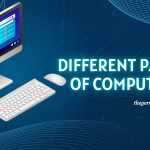Artificial Intelligence (AI)- What It Is & Why It Matters
What is Artificial Intelligence (AI)?
Artificial intelligence (AI) relates to the likeness of human intelligence in machines. Which are programmed to think like humans and mimic their activities. This may also correlate with any kind of machine that manifests features associated with a human mind, like learning and solving problems.
Artificial intelligence does it possible to learn machines from experience, perform tasks like humans, and adjust new inputs. In simple ways, it is possible to train machines using AI to perform tasks.
There are certain things you see but not recognized that are mainly based on AI technology, such as a chess-playing computer or self-driving cars, which rely on deep learning and natural language processing.
By processing large amounts of data and understanding patterns inside the data, machines can be trained to perform the particular task using these technologies. The absolute aspect of artificial intelligence is its ability to intellectualize and take actions that have the best opportunity of achieving a particular goal.
Machine learning is the subset of artificial intelligence technology, which refers to the idea that a computer program can adapt or learn new data without taking the help of or being assisted by humans. Deep learning techniques enable this automatic learning of unstructured data, like images or videos, through the absorption.
Understanding of Artificial Intelligence (AI)
The first thing that comes to mind when most people hear about artificial intelligence is Robots. This is because movies, novels, cartoons weave a story about human-like machines (robots).
Artificial intelligence is based on the belief that human intelligence can be defined in a way that machines can simply imitate it and achieve tasks, from the easiest to those that are even more complex.
The goals of artificial intelligence are to include learning, reasoning, and perception. AI is continuously growing to serve many diverse industries. Machines are filed using a multi-disciplinary approach based on mathematics, computer science, psychology, and many more.
How Does Artificial Intelligence Work?
Artificial intelligence works by linking high amounts of data with quick, iterative processing and understanding algorithms, allowing the software to learn automatically from the patterns or features inside the data. Artificial intelligence is a wide field of study and learns that includes lots of ideas, methods, and technologies. some of the major subfields of AI are as following
- Machine learning automates scientific model building. It uses techniques from statistics, operations research, and physics to discover hidden inside in data without explicitly being programmed for where to look for or what to decide.
- Deep learning practices vast neural networks with many layers of processing units, taking advantage of advancement in computing power and even improved training techniques to learn the complicated patterns in large amounts of data. Applications include image and speech.
- Computer vision depends on pattern identification and deep learning to understand what’s in a picture or video. When machines can treat, analyze and understand the images, they can easily capture images or videos in real-time and understand their surroundings.
- Natural language processing (NLP) is the capability of computers to analyze, understand and create human language, including speech. The NLP is a natural language interaction, which allows humans to interact with computers using everyday language to perform tasks.
Following are the technologies enable and support Artificial intelligence.
The Internet of Things creates huge amounts of data from connected devices, most of it unanalyzed. Automating models with artificial intelligence will allow us to use more of them.
Graphical processing units are key to artificial intelligence because they provide the massive computing power, which required for iterative processing.
Advanced algorithms are being formed and consolidated in new ways to analyze more data securely and at multiple levels. This intelligent processing is key to understanding and predicting rare events, recognizing complex systems, and optimizing unique scenarios.
APIs or application programming interfaces, are compact sets of code that make it possible to add AI functionality to existing products and software packages. It can also add image recognition capabilities that describe data, create captions and headlines, or call out interesting patterns.
How Artificial Intelligence Is Being Used
Health Care Artificial intelligence applications can read X-rays and provide personalized medicines. The personal health care assistant can guide you to take your pills, remind you about exercise or eat healthier.
Retail Artificial intelligence applications can read X-rays and provide personalized medicines. The personal health care assistant can guide you to take your pills, remind you about exercise or eat healthier.
Banking Artificial intelligence improves the speed, accuracy, and effectiveness of human efforts. In financial institutions, artificial intelligence techniques can be used to identify which transactions are likely to be false, adopt fast and accurate credit scoring, as well as it automates manually powerful data management tasks.
Why is artificial intelligence important
Artificial intelligence automates monotonous learning and discovery through data. Artificial intelligence is different from hardware-driven, robotic automation. Artificial intelligence performs regular, heavy computerized tasks reliably and without exhaustion instead of just automating manual tasks.
For this type of automation, however, a manual examination is required to build the system and ask the right questionnaire. AI adds intelligence to existing products. In many cases, artificial intelligence will not be sold as an application.
The products you are using already can be improved with the help of artificial intelligence capabilities Automation, conversational programs, bots, and intelligent machines can be combined with amounts of data to improve many technologies at home and in the workplace, from security intelligence to investment analysis.
Artificial intelligence automates monotonous learning and discovery through data. Artificial intelligence is different from hardware-driven, robotic automation. Artificial intelligence performs regular, heavy computerized tasks reliably and without exhaustion instead of just automating manual tasks.
For this type of automation, however, a manual examination is required to build the system and ask the right questionnaire. AI adds intelligence to existing products. In many cases, artificial intelligence will not be sold as an application.
The products you are using already can be improved with the help of artificial intelligence capabilities Automation, conversational programs, bots, and intelligent machines can be combined with amounts of data to improve many technologies at home and in the workplace, from security intelligence to investment analysis.
AI modifies through progressive learning algorithms to let the data do the programming. AI gets a structure in data so that the algorithm can acquire skills. The algorithm becomes a classifier or a medium.
The algorithm can teach itself many things like how to play a game of chess, it can also teach itself which product to promote the next online. Models can adapt when given the new data. Backpropagation is an AI technique that allows the model to adjust if the first answer is not right and through training.
Artificial achieves incredible accuracy using deep neural networks, which was earlier not possible. If you take the example of “Alexa”, google search and photos are all depending on deep learning, the more you search the more it gets accurate.
AI techniques from deep learning using in medical fields, from image classification and object detection can now be used to find cancer on MRI scans with the highly trained radiologist and with the same accuracy.
Artificial intelligence gets the most out of data. When the algorithms become self-learning, the data itself can become intellectual property. All the answers are present in the data, you just have to apply AI techniques to get them out. As the role of the data is more important now than ever before, it can create ambitious advantages. Even if everyone is applying similar techniques and you have the best data, the best data will win.




